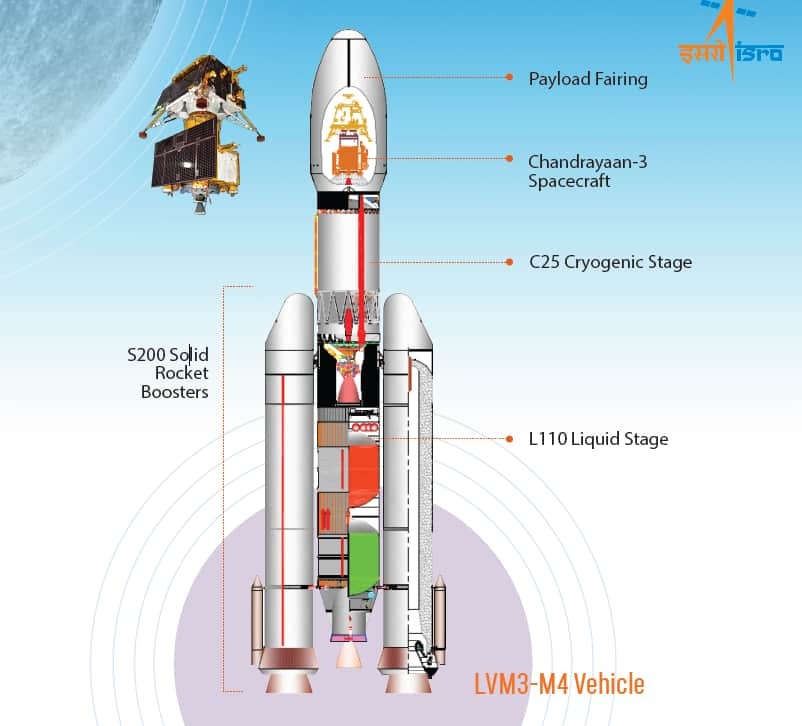



At around 2.30 pm on July 14, India will yet again venture out for the Moon in the third edition of Indian Space Research Organisation's (ISRO) lunar exploration mission named Chandrayaan.
This mission Chandrayaan-3 comes as a follow-up of the Chandrayaan-2 launch of 2019 which, despite providing valuable data and insights about Moon, failed in its main objective of making a landing on its surface.
It is important to remember that the 2008 Chandrayaan-1 mission was immensely successful and it had documented evidences of water molecules on the Moon.
Also Read Chandrayaan-3: The future of India’s lunar and space exploration hinges on this mission
Essentially, Chandrayaan 3 will try to do what its predecessor failed to do in 2019. The mission consists of a lander and a rover both retrofitted with payloads that will land on the moon and conduct various experiments.
The lander and the rover will be sitting inside a spacecraft that is being launched aboard ISRO's Launch Vehicle Mark-III or LVM3, a three-stage medium-lift rocket. It is set to liftoff from SDSC SHAR in Sriharikota, Andhra Pradesh.
This mission comes at a time when ISRO, according to the newly-unveiled Indian Space Policy, is looking to transition from its role of manufacturing operational space systems to focus on R&D, proving newer systems of space objects and so on.
The Chandrayaan-3 spacecraft sits inside the upper stage of LVM-3 rocket known as C25 (at the top of the rocket).
 What the LVM-3 consists of and a look at where Chandrayaan 3 will be resting | ISRO
What the LVM-3 consists of and a look at where Chandrayaan 3 will be resting | ISRO
After the rocket lifts off from Sriharikota, and reaches a specific orbit above Earth, the Chandrayaan spacecraft will separate from LVM-3's C25 upper stage and will then make its way towards Moon.
 A look at the different separation stages of LVM-3
A look at the different separation stages of LVM-3
The spacecraft is equipped with a propulsion mechanism that will take it to a lunar orbit as close as 100 km from the surface.
Thereafter the lander and rover will separate from the propulsion mechanism and then try to make a soft landing on the surface of the moon.
A look at the lander and roverFirstly the lander will have the capability to soft land at a specified lunar site, after which the rover will be deployed which will carry out chemical analysis of the lunar surface.
 The Chandrayaan 3 spacecraft equipped with a propulsion mechanism, rover and a lander
The Chandrayaan 3 spacecraft equipped with a propulsion mechanism, rover and a lander
The lander is equipped with technologies such as altimeters, velocimeters, inertial measurement package, propulsion system, navigation and guidance control, hazard detection and avoidance mechanism and landing leg mechanism.
Why Moon?In 2019, in the lead up to the Chandryaan-2 mission, ISRO had provided a expansive reasoning behind why the country wants to go the Moon
- ISRO said, "Moon provides the best linkage to Earth’s early history. It offers an undisturbed historical record of the inner Solar system environment."
- Evidence for water molecules discovered by Chandrayaan-1, required further studies on the extent of water molecule distribution on the surface, the body said.
- "There could be a possibility of presence of water in permanently shadowed areas around the Lunar South Pole," it added.
- Lunar South Pole is where Chandrayaan 2's rovers attempted to descend, and where Chandrayaan 3 is expected to go too.
Discover the latest Business News, Sensex, and Nifty updates. Obtain Personal Finance insights, tax queries, and expert opinions on Moneycontrol or download the Moneycontrol App to stay updated!
Find the best of Al News in one place, specially curated for you every weekend.
Stay on top of the latest tech trends and biggest startup news.